Stamp Dealers Mail
STAMP DEALERS MAIL
by Colin Baker
I am sure that many of us receive items of postal stationery through the post that we have bought in auctions or on ebay. Unless we can attend a stamp fair or an auction in person, it is about the only way we will be able to obtain new additions to our collections. Some auction houses and stamp dealers in the UK use the new horizon labels; those plain, large, white, self adhesive squares of paper that do nothing to enhance an envelope or encourage the younger generation to start collecting stamps. But other dealers still try to give us something extra by using commemorative stamps or miniature sheets. Some are even able to use postal stationery, especially if they operate from a country outside Great Britain.
More or less from the start of philately itself, dealers have always tried to go that little bit extra for collectors, without asking anything in return, apart from continued custom from their clients. From the end of the 19th and well into the 20th centuries, British stamp dealers used a number of ways of making their letters and packets more attractive. I've picked up some of these items when browsing boxes of postal stationery at stamp fairs, or occasionally some have turned up in auction lots. They can make an interesting sideline to a collection, or even a main subject in themselves, and I thought I would share these with you.
I cannot decide if these items should be classified as philatelic creations, since some have been deliberately prepared for stamp collectors, or whether they can fall under the heading of 'commercial covers'. After all, even though they may have paid the postage in some unusual ways, they did serve a postal purpose, paying for letters or goods sent through the post. Perhaps they are a mixture of both. If you give a selection of stamps to anyone who is not in a hurry, ask them to stick the appropriate amount onto an envelope, most will use a little artistic skill in fixing the stamps in an attractive group.
So what did the stamp dealers of years ago use? Prepaid parcel labels are difficult items to find in any reign. So I was lucky to pick up the one illustrated here [Fig 1] produced by Whitfield King, the stamp dealer based in Ipswich in the East of England.
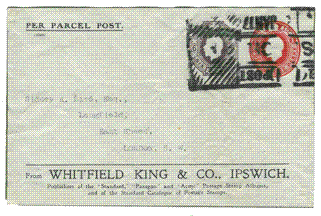
Fig 1
This dealer also used stamps cut from postal stationery to pay for the postage on letters. Cut out stamps had been banned from 1870 when postcards and newspaper wrappers were introduced, but were permitted again from 1st January 1905. The envelope shown as [Fig 2] is quite an early example having been sent on 7th April 1905. The return address has been added using a rubber stamp, but a later envelope used in 1909 has much more detail printed in the top left corner [Fig 3].
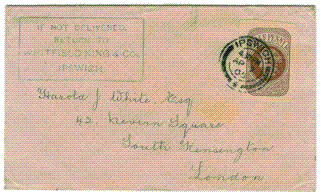
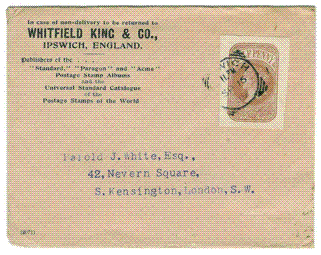
Figs 2 and 3
Whitfield King also had their own registration envelopes printed in Queen Victoria's reign, but were unable to have the Post Office registration die impressed on them, having to be satisfied with the normal STO dies [Fig 4].
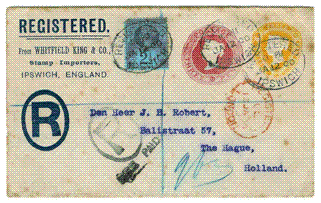
Fig 4
One other odd way of paying for postage which Whitfield King employed, was to use stamped to order (STO) envelopes as parcel post labels. The two examples I have acquired [Figs 5 & 6] would have paid for fairly heavy parcels, probably containing stamp albums or catalogues.
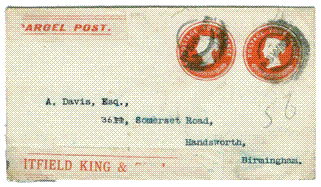
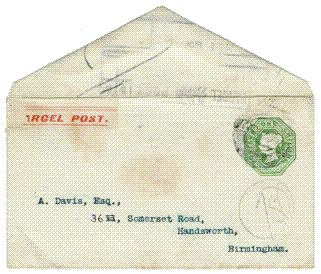
Figs 5 and 6
Of course Whitfield King was only one of several important dealers in the United Kingdom. Alfred Smith, who started off his business in Bath, produced numerous combinations of STO envelopes with different advertising vignettes. He had his name and business interest printed above and below some of the impressed postage stamps, [Fig 7] a kind of simple advertising ring.
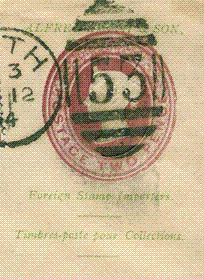
Fig 7
He also printed a drawing of his premises in Bath on the left hand side of envelopes [Fig 8]. However, I think he was probably exaggerating the size of his premises, and in all probability had one small shop on the ground floor.
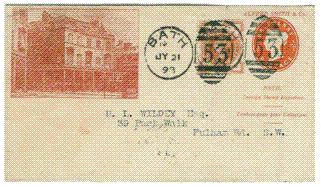
Fig 8
These envelopes were used up following his move to London by being overprinted with his new address details [Fig 9]. I have not seen any fancy Alfred Smith envelopes used after this period, but he continued to use rather more plain envelopes, which would have been much cheaper to print [Fig 10].
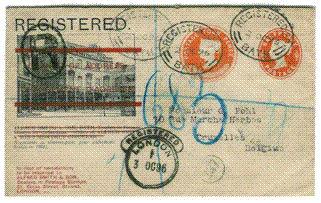
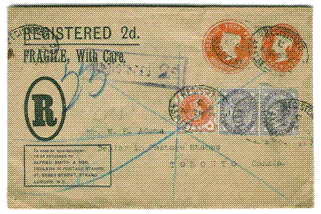
Figs 9 and 10
Another of the philatelic dealers who operated in South London was L'Estrange Ewen. He had parcel labels specially produced for posting heavy albums and catalogues [Fig 11].
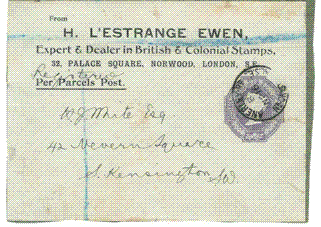
Fig 11
Another dealer from the same area was Oswald Marsh. He also had labels made up for sending out parcels of albums and catalogues [Fig 12] and sometimes sent out his weekly lists using cut out stamps [Fig 13].
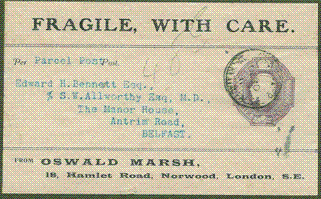
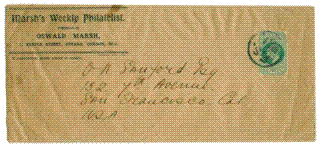
Figs 12 and 13
One, or perhaps both of these dealers also sent out registered letters to many clients, probably containing new stamp issues. Some of the envelopes were pre-stamped [Fig 14] while the postage on others was paid for using stamps cut from items of postal stationery [Figs 15 & 16]. This particular example, with 'am........' still visible along the top of the cut out, clearly shows that the King Edward VII 6d stamp has been taken from a telegraph form.
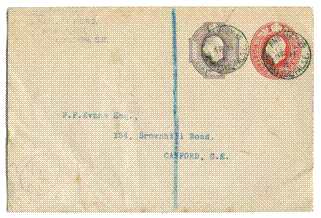
Fig 14
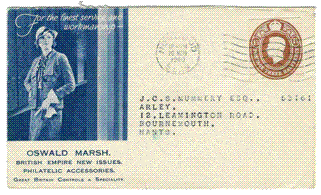
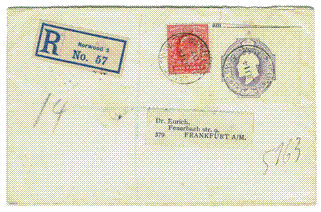
Figs 15 and 16
Another London dealer, the Williams Stamp Company of 120 Leadenhall Street, EC, also used stamps cut from postal stationery. In all probability the 6d stamp in [Fig 17] has also been taken from a standard telegraph form. These could be obtained from the Post Office at their face value, unlike the envelopes sold by them which always carried a premium to cover the cost of the envelope. So if the postage demanded it, it was cheaper for the dealer to use a stamp cut from a telegraph form rather than several envelopes.
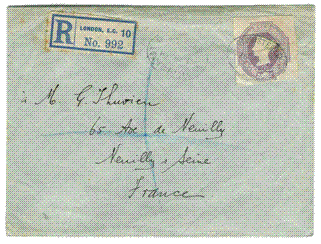
Fig 17
William Lincoln produced printed albums for collectors and had his own envelopes created with his personal advertising ring subsequently printed around the stamp. Some of these were used as cut outs in the beginning of the last century, and one example [Fig 18] uses these to pay part of the postage on a large parcel to South America.
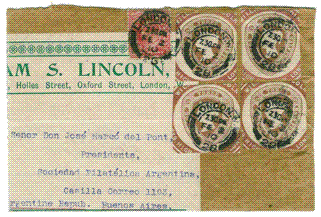
Fig 18
Although I only have a mint example of one of these envelopes [Fig 19], I am sure they were also used for corresponding with philatelists. Also indulging in advertising rings on envelopes were the Philatelic Quarterly and the Publishers of the Permanent Stamp Album, both based in Brighton [Figs 20 & 21]. But I have never seen any other type of cover that I can identify as being from these last two dealers.
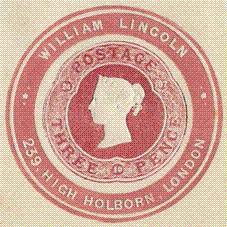
Fig 19
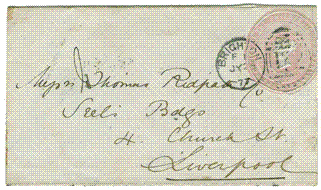
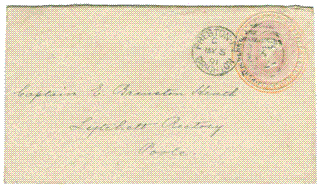
Figs 20 and 21
Another dealer based in the Channel Islands, Charles & Co., had unstamped reply postcards produced. He sent these to collectors to promote his approvals selections, with the reply half intended for collectors to tell Charles & Co. of their wants lists. He also used stamps cut from postal stationery to make his mail more attractive to collectors [Fig 22]. The note on the reverse is interesting [Fig 23]. "We also have post cards, envelopes, cut squares and fiscals, which we sell cheap". There was not a great deal of interest in postal history or postal stationery in those days!
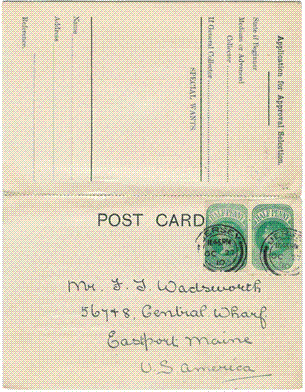
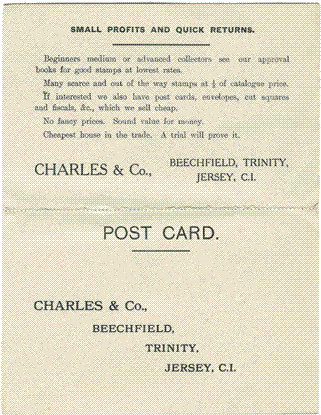
Figs 22 and 23
One well known dealer who operated from Stockwell, London, was H Edgar Weston. He produced a huge amount of philatelic material and had his stamps specially printed in sheets of 48. But his story will have to wait for another time.
Even today one or two dealers in Britain still try to enhance their packages, using postal stationery envelopes and cut out stamps. [Fig 24] shows one I received a couple of years ago from Andrew Whitworth, paid for with stamps cut from air letters. Regrettably Andrew is no longer trading.
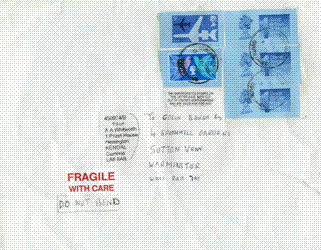
Fig 24
Our society still uses overprinted postal stationery [Fig 25] and about 10 years ago had its own prepaid envelopes printed in the unusual colour of puce [Fig 26].
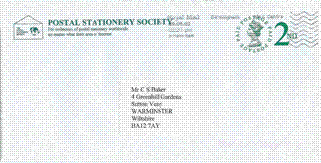
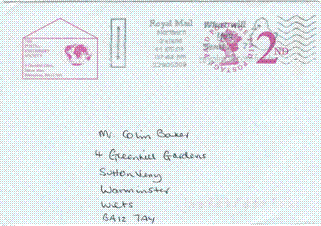
Figs 25 and 26
So with all this material, collectors of 75 or 100 years ago must have been served very well indeed. There were envelopes and parcel labels, stamped to order envelopes, cut outs from various sources and advertising rings for those who patronised the right dealers. Fortunately for us collectors today, many of these items have survived so that we can tell the story of Victorian and Edwardian dealers.
Finally, this article is based on items from my own collection. As I said at the beginning, I have not gone out of my way to collect this material, but have come by it while hunting for other types of postal stationery. No doubt there are many more dealers from the last two centuries, who enhanced their envelopes and packets when writing to their clients. Of course there are still some today who continue to do so. So if anyone can add to this story of philatelic fancies, please let me know and we will try to publish an update to this article in the future.
(This article is reproduced from the August 2010 issue of the Postal Stationery Society Journal.)
